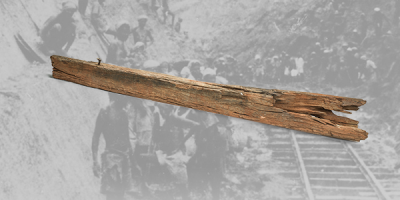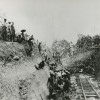Burma Railway Crosstie
From the collection of Museon (Museum of Science and Culture), The Hague

h 14 cm x w 192 cm
1942-1943
The Japanese occupier in the Dutch East Indies forced Western men and Dutch Indonesians of the colony to work as slave labourers. Thousands of men, who were first vigorous, strong and healthy, suffered terribly under the wretched conditions. All day long they toiled in the burning sun and almost unbearable heat to lay the infamous Burma Railway.





They had to level the ground and excavate sand. They sometimes worked day and night, tormented by thirst and gnawing hunger. The overseers were armed with bamboo sticks and guns. The 415-kilometre Burma Railway runs right through Thailand and Burma. The estimated number of dead prisoners ranges from 100,000 to 200,000. The majority were Dutch Indonesians. Fifteen thousand prisoners of war, including 3,000 Dutch POWs, died there as well. It is probably safe to say that there is somebody buried beneath every railway crosstie.





